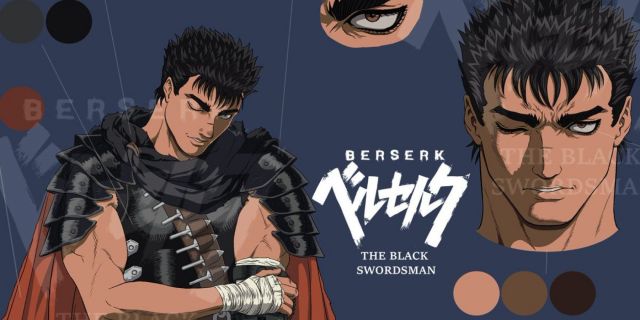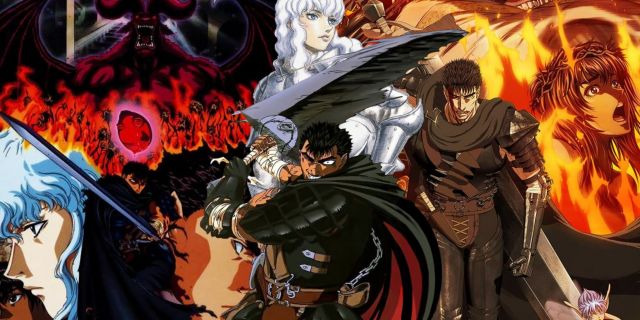Highlights
- Kentaro Miura’s “Berserk” is a universally acclaimed manga known for its story, characters, artwork, themes, and world-building.
- Despite multiple anime adaptations, none have fully captured the essence of what makes “Berserk” a legendary manga.
- Adapting “Berserk” to anime faces challenges in translating Miura’s intricate art style and mature themes while maintaining the story’s essence.
Lists or rankings concerning the greatest manga of all time generally feature a few titles in common, and chief among them is likely none other than the late Kentaro Miura’s Berserk. A grim dark fantasy epic rendered with incredible precision and panache, Berserk has received near-universal acclaim for its story, characters, artwork, themes, and world building.
Over the three decades since the manga began serialization, there have been three separate anime adaptations, including the 1997 anime, the Golden Age Arc film trilogy, and the ill-fated 2016 series. While each retelling of Guts’ story has its fair share of pros and cons, the prevailing opinion is that none of them fully capture the essence of what makes Berserk one of the greatest manga of all time. Hence, will there ever be a day when Miura’s magnum opus gets the anime adaptation it deserves?
Honoring Kentaro Miura’s Unparalleled Legacy
Kentaro Miura is widely hailed as one of the most accomplished manga artists in history, and his untimely demise in May 2021 struck a desolate chord in the hearts of all those whose lives had been changed by his work. After having devoted more than three decades of his life to Berserk, Miura’s passing cemented the fact that his masterwork would never be truly finished by his own hand, bringing his version of the manga to a tragic end.
Since then, the manga’s production has been taken over by Kouji Mori — a close friend of Miura’s — alongside Studio Gaga, the group of artists who worked on Duranki, another project that was formerly helmed by Miura. Needless to say, this team has faced an immense level of pressure to maintain Miura’s standards and see Berserk through till its end, and similar expectations have been forced upon anime adaptations of the series.
While Miura may not have been too involved in earlier anime adaptations of Berserk, the current prospect of executing a new production of this story is an even more daunting task, given all that has happened with the series in the past few years. Any anime retelling of Berserk that fails to do justice to his work would only be another addition to the graveyard of past adaptations that failed to make the cut. This adds another layer of pressure, since past attempts to bring Berserk to screens have always fallen short.
What Went Wrong In Earlier Adaptations
A key indicator of the follies of past adaptations can be seen in how Berserk (1997) is still somehow the best introduction to the series through the medium of anime. In spite of its abundant still frames and dated animation, this production — executed by Oriental Light and Magic under director Naohito Takahashi — captured the soul of Berserk’s Golden Age Arc better than any of its successors. That being said, the series did make compromises in terms of censorship and the elimination of the story’s supernatural elements.
Next, the Golden Age film trilogy (2012 – 2013) by Toshiyuki Kubooka and Studio 4°C is an updated take on the story, featuring higher quality animation and a more modern art style. On the face of it, these movies do well to replicate some of Berserk’s battles and dynamic action sequences, but the constraints on their respective run times forced the story to be heavily condensed. This led to the omission of a number of important character moments and plot elements that held great significance, and would become relevant later on.
Finally, not much needs to be said aboutBerserk (2016), given the unanimously poor reception it has received over the years. Shin Itagaki, Liden Films, GEMBA, and Milleensee’s attempt to create a fully 3DCG-based take on Berserk’s Conviction and Falcon of the Millenium Empire Arcs was as poorly contrived as it was executed. The many criticisms levied at this production have made it a poster child for “what not to do” when adapting an acclaimed manga, and this is quite disheartening when looking at all the talented individuals involved in the project.
The Challenges Of Adapting Berserk
Among the greatest obstacles currently hindering an ideal anime adaptation of Berserk, is the task of translating Miura’s art style from the manga into the medium of anime. Miura’s hand-drawn art made heavy use of traditional ink rendering and hatching techniques, to create deep shadows, varied textures, detailed backgrounds, and layered frames.
Once he switched to drawing the manga digitally in later years, there was a noticeable shift in its aesthetic, although the vast majority of Berserk prior to this change was still drawn in pen and ink. Besides this, Miura’s use of paneling and action lines to convey motion, momentum, and emotion, have yielded some incredibly iconic manga panels, and it would be a mammoth task to replicate their quality in a different medium.
Even for a seinen manga, Berserk incorporates a considerable amount of gore, violence, and very mature themes in its narrative, far exceeding what most R-rated media franchises would usually have in their repertoire. Although such content may be hard to digest for some readers, it is important to note that the series never falls to the level of exploiting these elements for shock value.
However, the issue with toning down parts of the series for the medium of anime is that it may dilute the bleak, morally gray essence of the story. Die hard fans of the manga would argue that Berserk shines brightest due to its brutally honest depiction of the harsh realities of its world — and they are more than justified in sticking to this belief.
Unfortunately, it would also not be feasible to adapt the series without trimming down its most unsavory bits, since no distribution platform would be able to justify hosting Berserk in its full, uncensored glory. On the face of it, Berserk is neither simple nor a straightforward story by any means. For starters, the manga begins near the mid-point of the chronological narrative, before leaping into a lengthy flashback that gives more context to the connections between the main cast.
Moreover, the story displays considerable shifts in pacing, where some segments go by at a frenetic rate, whereas others require more time to breathe. Such contrasts are far from ideal for an anime adaptation, which would benefit from consistent peaks and troughs in its pacing. These are but a few of the major hurdles that any future adaptation of Berserk will have to face.
Is There A Reason To Be Optimistic?

Since there is an end in sight for the manga, the future does look somewhat promising for the franchise, even after the tragedy that befell its creator not too long ago. On a similar note, there appear to be some collectives who are still interested and willing to take on the risk of adapting parts of Berserk, if not all of it. One such example can be seen in an ambitious fan animation project by a group known as Studio Eclypse, who are currently working on an adaptation of the Black Swordsman Arc.
Although it is heartening to see the series’ fan base striving to produce an endeavor of this scale, one can only hope that it will fare better than past forays into the almost Sisyphean venture of adapting Berserk. Perhaps when the manga is finally done, there may be good cause to consider a new adaptation of the series, but it would also not be too surprising if Berserk forever remains a story that is best enjoyed in its original form.
Berserk is available to stream on Netflix.











Leave a Reply